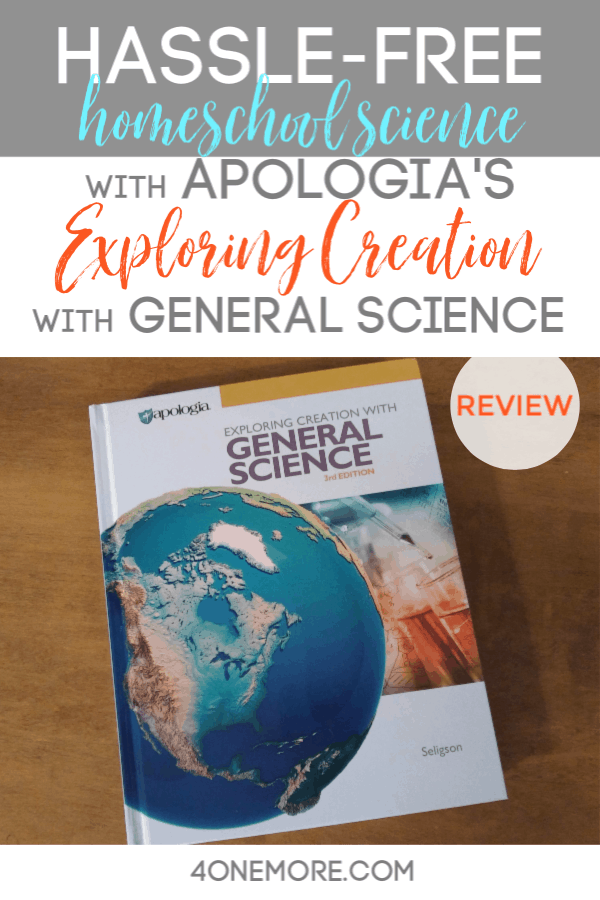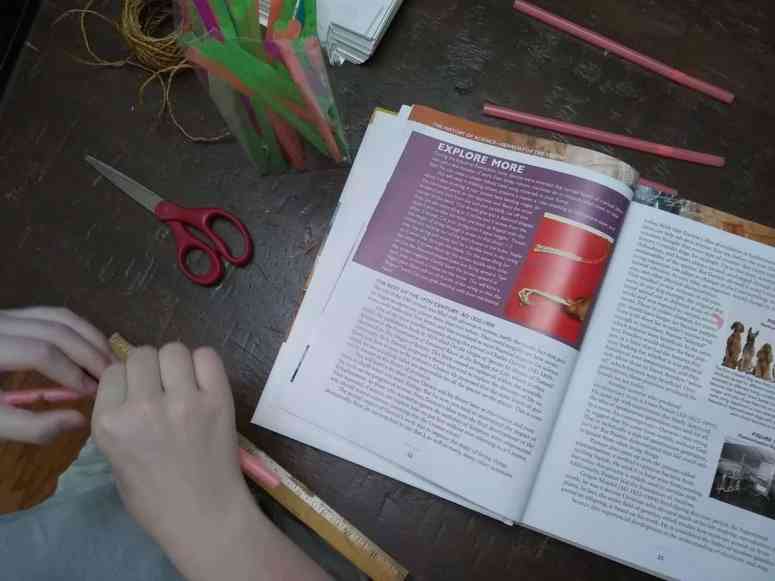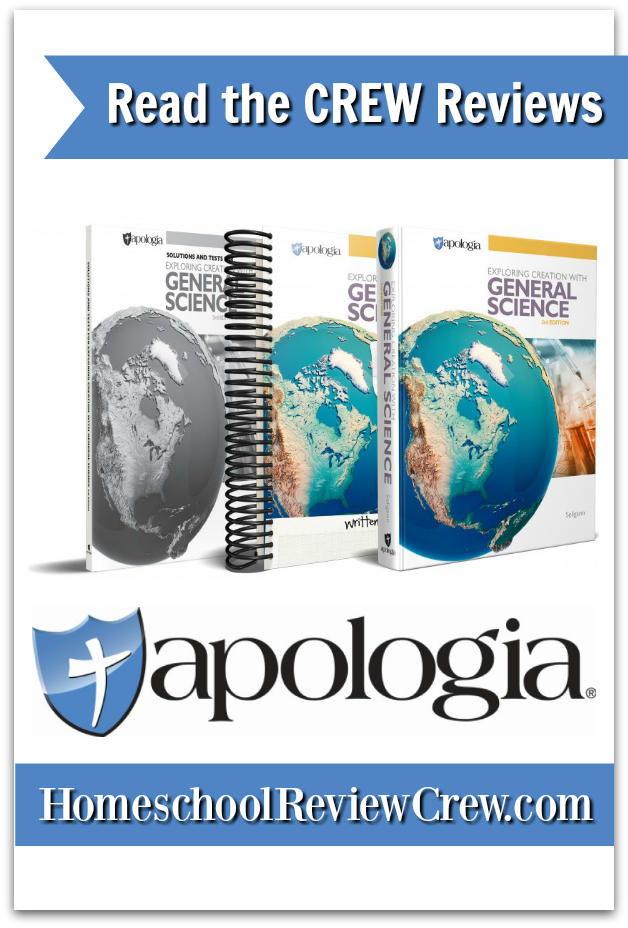My 13-year-old has been working through Exploring Creation with General Science, 3rd Edition from Apologia and I’m reminded again how this curriculum makes homeschool science hassle free.

My posts contain affiliate links.
Complete General Science Set
We received the entire Exploring Creation with General Science, 3rd Edition set. This is what is included:
- Hardcover Textbook
- Softcover & spiral-bound Student Notebook
- Tests booklet
- Solutions & Tests manual

Apologia science curriculum is written from a Christian worldview, with biblical creation as the foundational starting point.
The Exploring Creation with General Science, 3rd Edition curriculum covers these topics:
- The History of Science
- Scientific Inquiry & the Scientific Method
- Documenting & Interpreting Experimental Results
- Scientific Analysis & History
- Astronomy
- Geology & Paleontology
- Meteorology & Oceanography
- General Chemistry
- General Physics
- Life Science
- General Biology
- Marine Science
- Environmental Science
- Science & Creation
The final module acts as a “bookend” to the course. In module 1, students learn about the many scientists throughout world history. Module 14 completes the course by introducing present-day scientists from a variety of fields.
Module 14 doesn’t include a test to assess learning, but rather the final experiment of the course spans the entire module as students construct a Rube Goldberg Machine from end task to beginning. I can’t wait until we get to this module! Sounds like the perfect way to end a general science course.
Textbook
Using the Exploring Creation with General Science, 3rd Edition curriculum is one stop on that pathway to independent learning. My 13-year-old worked on this subject mainly independently after familiarizing himself with the format and expectations.

The hardcover Apologia General Science textbook is beautifully formatted with easy to read text and color illustrations. It includes 14 modules, which are suggested take about 2-2.5 weeks each to complete.

My kids love the conversational style of the Apologia texts. No more dry and boring science textbooks for us.
If you follow their suggested course schedule and have your student work on it four days per week for about 45 minutes to 1 hour, then they will finish in 33 weeks. This gives some much-needed buffer for most homeschool families.
Each module in the textbook includes these features:
- vocabulary words in blue bold font with definition
- experiment instructions & procedures
- “On Your Own” questions keep the student accountable for mastery of the content
- Explore More are additional hands-on learning activities
- What to do are instructional boxes that help the student in the first few modules know how to complete assignments, lab reports, and study guides. It’s a great help as students familiarize themselves with the format of this curriculum.
- Answers to On Your Own questions – which allow students to self-assess their answers
- Study Guide (The Student Notebook includes this)
The back of the textbook contains a handy Lab Supply List, organized by module. The science experiments use readily available items from the grocery or hardware store, so that you’re not having to buy specialized resources.

Student Notebook
We have used Apologia science curriculum before, and from experience, I highly recommend the Student Notebook.

The Student Notebook helps kids learn how to learn. From including room for notes, experiment details, graphic organizers, and diagrams, it helps to teach students which information is the most important and shows them the best way to visually organize it and record it.

Exploring Creation with General Science, 3rd Edition takes kids from an elementary science experience to a complete middle school experience in preparation for high school.

In the elementary years, having nature journals and low-key assignments like free-form notebooking is ideal. But in the middle school years, it’s well worth the time to use a resource like Apologia’s Textbook and Student Notebook to help kids along on the journey to independence.
By the time they get to high school, they should be able to work through an Apologia course on their own. No extra knowledge needed from you!

Here’s a list of some of the most helpful parts of the Student Notebook:
- Complete instructions for parents about how to approach teaching note taking to their students
- Explanation of grading
- Experiment Grading Rubric
- Exams and Grading explanation
- Notes written directly to the student about using the Student Notebook and taking notes effectively
- Suggested Daily Schedule (this is awesome! and essential to stay on track)
- Each module includes graphic organizers for: note taking, answering On Your Own questions, and Study Guide questions.

Test Booklet
The test packet includes one test per module, in an easy-to-tear perforated format.
I have found that Apologia tests are not a “regurgitate the facts” kind of assessment. No – they actually are applicational and really do see if the student understands the content.

They are similar in question type and content to the study guide in the student notebook, so most students will learn quickly that if they can understand the study guide and the On Your Own questions throughout the module, they will do very well on the test.
Solutions & Tests Manual
This book gives the solutions to the study guides and tests for each module as well as the solutions to the study guides and tests.

What I find so helpful about their format is that in addition to noting the correct answer to a question, they also include a paragraph of explanation that helps me and my student understand why they might have gotten one wrong.
The solutions manual designates how many points each test question is worth. So, short one-word answers might be 1 point, while longer explanations are 2-3 points.
Each test includes a “Grading and Weighting Example” box that shows how to calculate the student grades for the course. It also explains how to grant partial credit for students who correct their wrong answers on tests.
How we used Apologia General Science
My 13-year-old worked through Module 1 during our time with this curriculum.
The first module was The History of Science, which included a great overview of the main scientific discoveries from ancient times to present.
He consulted the daily schedule in the front of the Student Notebook, which specified exactly which pages to read (Text) and then which pages to complete in the Student Notebook (NB). If there are experiments to complete, then the schedule will note that as well.

My son read the textbook pages and took notes or completed diagrams and timelines in the Student Notebook.
The first experiment he did was about density. Armed with a jar of popcorn kernels, a ping pong ball, and a lead sinker, he was a bit surprised at the outcome.

Lab Reports are included in the Student Notebook for each module, so before, during, and after each experiment he recorded the appropriate information.
The second experiment was to test chemical reactions that happen when copper pennies are exposed to lemon juice. This one didn’t turn out as great for us, but this curriculum is great because even if an experiment “flops,” the text still explains what you should have seen during the experiment and why.
Finally, my teen created one of the hands-on activities in the Explore More section by making a simple robotic hand using common household objects.


7 Reasons why it’s great for homeschool
The more we use homeschool science curriculum from Apologia, the more we love it. Here are just a few reasons why:
- Homeschool moms don’t need science expertise
- Curriculum is written in an interesting & conversational tone to the student
- Teaches independence through the Student Notebook
- Teaches note taking skills
- Tests require higher order thinking skills rather than rote memorization
- Clear daily expectations
- Includes hands-on components with experiments

Find lesson plans available for this product at Homeschool Planet. Sign up for a 30-day FREE trial.
Recommendations
Exploring Creation with General Science, 3rd Edition is recommended for 7th grade. I think it could be used anytime between 5-8th, and even into 9th if your child hasn’t had a solid science foundation.
This curriculum also includes a URL and password to access additional third-party links and content to use with the textbook.
Apologia also offers an Apologia Video Instruction Course for this title as well as live and recorded classes from The Apologia Online Academy.
I know that by using Apologia science curriculum, my kids are getting a better science education than I did as a student in a private Christian school.
If you’re looking for a solid science curriculum from a Christian worldview, then Apologia General Science is a great choice. We’ve been very happy with our experience with the Apologia curriculum at the middle school and high school levels in our homeschool.
Check out our review of Apologia Botany for students in grades K-6.
But don’t take my word for it! See what other homeschool families think about Apologia General Science by reading additional Crew Reviews.

